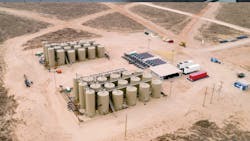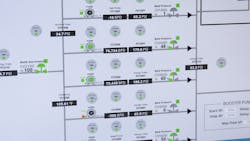NGL Energy Partners is a diversified midstream oil & gas company that provides multiple services to producers and end users, including transportation, storage, blending, and marketing of crude oil. To improve its operational efficiency and revenue generation, NGL embarked on an ambitious project that created a new supervisory control and data acquisition (SCADA) system for its saltwater disposal facilities. The new system connects assets in several states and provides communication from site to site. The result is a smart field that includes 114 water treatment and disposal facilities, 178 pipeline tie-ins, 31 boosters, and around 1.25 million tags.
The site-to-site communication allows NGL to optimize its routing of wastewater among its locations. Each node in a sector knows the capacity at other nodes, allowing NGL to maximize usage and revenues. The new system also improved NGL’s operational efficiency and opportunities for data analysis.
“The biggest challenges of this project were the remote locations and limited bandwidth,” said Matt Jones, director of operational technology for NGL. “Also, we started from scratch. There was no infrastructure in place, from communication to servers, and TAS was a great help in building out that architecture.”
TAS is system integrator Texas Automation Systems.
“This project for NGL was large,” said Will Baker, automation consultant with TAS. “It was meant to cover a vast majority of their assets that are distributed across different states. It served a purpose for all their operations, from the field level back to their enterprise.”
For its new SCADA system, NGL chose Ignition by Inductive Automation® — an industrial application platform with tools for building solutions in SCADA, human-machine interface (HMI) and the Industrial Internet of Things (IIoT).
“We needed a SCADA system that was reliable, that could rapidly expand, and we needed repeatability. Because of that, we chose Ignition,” said Jones.
TAS also brought in Cirrus Link Solutions for its unique MQTT expertise. Arlen Nipper, president and CTO of Cirrus Link, co-invented MQTT with Andy Stanford-Clark. Cirrus Link provided the MQTT modules that were needed.
“I really like how excited both NGL and TAS were with the outcome of this project,” said Nipper. “When you consider that they did 114 sites, with over a million tags, and they did that whole project in eight months, it’s incredible to see how they leveraged all the technology. Projects of this size are typically measured in years, not in months.”
Unlimited licensing
NGL’s solution includes MQTT publish and subscribe capabilities among edge devices — going beyond the usual method of edge devices publishing but not subscribing. The new SCADA system also provides scalability, flexibility and rapid development. It also includes Ignition’s unlimited licensing, which means there are no additional costs for adding clients, screens, tags, devices, or connections.
“The unlimited licensing model gives us peace of mind,” said Jones. “We were able to rapidly grow our system without constantly going back and requesting new licenses for additional tags.”
The new system also gives NGL more insight into its data.
“It’s really changed the way NGL does business, from the way we operate our facilities, to importing large amounts of data into data lakes and performing analytics,” said Jones.
Faster development has also helped.
“The ability to create templates inside the SCADA system allowed NGL and TAS to rapidly deploy custom screens for our facilities,” said Jones. “We have over 600 different views.”
Conditions change quickly in the field, so NGL appreciates the ability to make changes on its own. And Ignition Perspective gives NGL numerous mobile capabilities.
“Perspective was a huge deciding factor in NGL selecting this as our SCADA system,” said Jones. “Operators in the field seeing real-time data on mobile devices has been a real game-changer for us.”
NGL now has a deeper look into its saltwater disposal operations.
“When they have trucks coming in, they don’t have to reject any water, because they’re able to move that water to a facility that has capacity to take it,” said Brad Byrum, president of TAS.
That’s good news for NGL.
“The two biggest benefits of this SCADA system have been our increase in operational efficiency and revenue generation, as we’re better able to utilize our assets,” said Jones.
Crucial pieces
MQTT was especially helpful in dealing with two key issues for NGL: remote locations and limited bandwidth.
“The benefits of MQTT were the low bandwidth consumption, which helped with our cellular communication, and the ability to push all the data from the edge to a centralized broker, and then share that information with anyone who wanted to subscribe to it,” said Baker.
“MQTT was critical to this project,” said Byrum. “Its ability to do publish/subscribe at the edge was extremely valuable. And its reduced bandwidth requirements enabled us to use cellular modems for almost all the communications at the edge, which would have been difficult to do using normal polling technologies.”
“NGL wanted to use MQTT to do some pretty disruptive stuff in their SCADA system,” said Nipper. “Not only did they want more secure, redundant, and reliable communications into the central gateway, but they also wanted to accomplish peer-to-peer communications.”
Enabling this site-to-site communication at the edge required customization of Cirrus Link’s MQTT modules, but everyone worked together to produce the needed solution.
“This project would not have been possible within our timeline without the tight coupling between Ignition and Cirrus Link,” said Jones.
TAS’ Baker also observed how crucial those pieces were.
“The two most important aspects of the project were the use of Ignition and the use of MQTT,” said Baker. “This helped us create the smart field idea that NGL came to us with, and offered quick deployment, and everything that NGL was looking for.”
Collaboration, and the right tools
Nipper said the Sparkplug B specification — which defines how MQTT should be used in industrial settings — saved a lot of time.
“With 114 sites and over a million tags, TAS couldn’t spend a lot of time configuring tags at both remote sites and the headend,” said Nipper. “So with Sparkplug, they could define the tags in the field and have those automatically published and discovered at the Ignition gateway. This gives NGL a single source of truth.”
Like Nipper, TAS’ Byrum was impressed with the speed at which the solution was created.
“The most interesting aspect of this was the high degree of collaboration between Inductive Automation, Cirrus Link, and our development team to create a custom gateway that enabled pub/sub at the edge. That hadn’t been done prior to this project,” said Byrum.
NGL’s new SCADA system has been so popular, more and more people are using it.
“When we rolled out this system, our ops team was the first to utilize it,” said Jones. “Now our accounts team, execution team, and executives all use the platform.”
NGL has gradually taken over the development from TAS, and it’s been a smooth transition. “NGL is now doing the development,” said Byrum. “The training capabilities and support from Inductive Automation allowed NGL to really own their destiny with this platform. And that’s great for them, and ultimately great for everybody. It’s great for the industry.”
Jim Meyers is Communications Manager at Inductive Automation, creator of the Ignition industrial application platform for SCADA, HMI, IIoT, and more.






